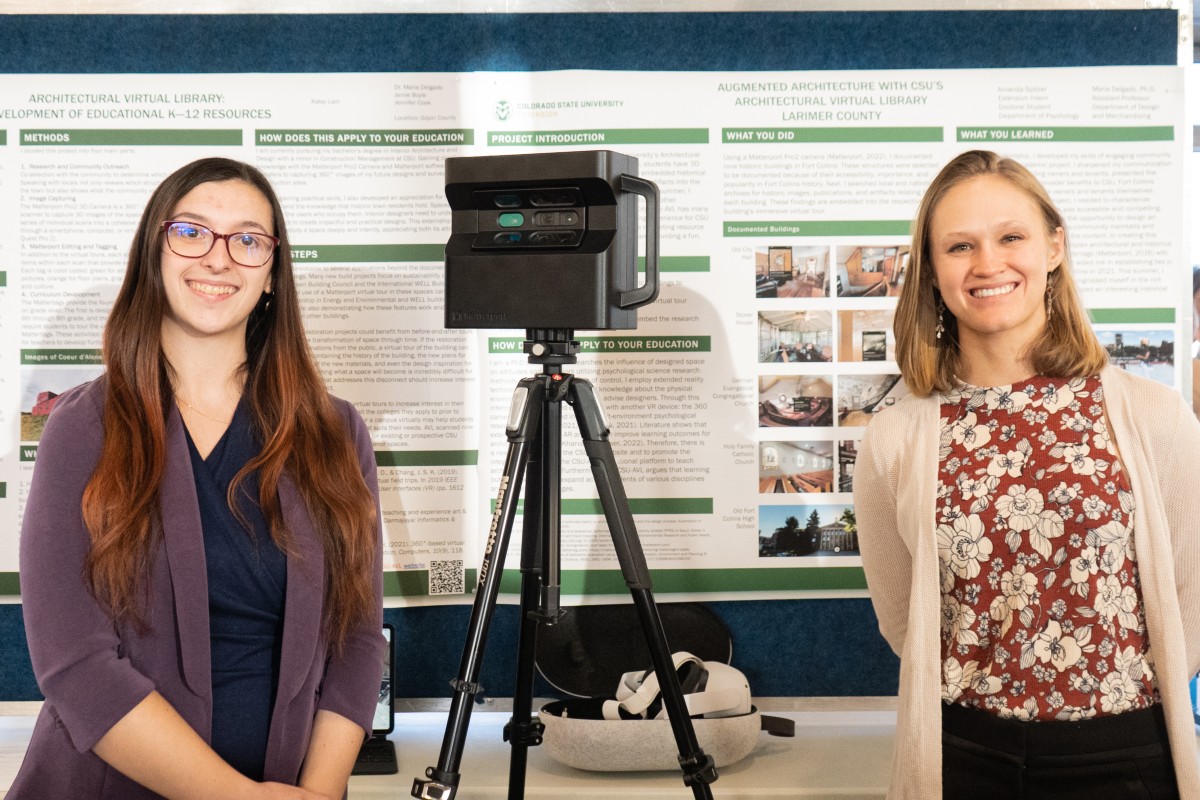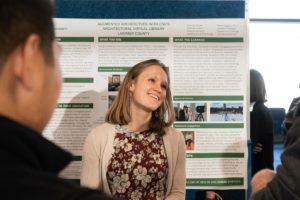
New advances in technology are now allowing for alternate ways of learning, such as the Architectural Virtual Library program.
Maria Delgado, assistant professor in the Department of Design and Merchandising at Colorado State University, launched the AVL project, an interactive website designed to educate the public on architectural historic buildings – both on and off campus.
Users can engage with the content in the Architectural Virtual Library through 3D Matterport technology, integrating virtual, augmented renderings of buildings where users can travel through and discover distinct architectural characteristics.
New additions to the Architectural Virtual Library
Last summer, the AVL was launched with augmented tours of buildings in Sterling and on CSU’s campus completed by interior architecture and design student interns.
This summer, two more interns majoring in interior architecture and design and behavioral psychology were able to work on the AVL. With the use of Matterport technology, the students focused on creating content in Central City and Fort Collins. For both Central City and Fort Collins, there are nine buildings for each city on the AVL website that can be virtually toured and explored.
Katey Lam was tasked with working on the AVL content for Central City while Amanda Spitzer took on the AVL content in Fort Collins. Lam created virtual tours in Central City while Spitzer did the same in Fort Collins, both of which are all new additions to the AVL website.
Both this year and last year, the internships were made possible through the Office of Engagement and Extension’s CSU Summer Extension Internship Program which seeks to connect the University and communities by engaging students in hands-on outreach projects at the local level.
Exploring Central City
Lam’s Central City project focused on creating educational materials for K-12 students, using the virtual capabilities of the AVL to foster an engaging mode of learning.
Lam is currently pursuing her bachelor’s degree in interior architecture and design with a minor in construction management at CSU.

“Beyond gaining practical technology skills, I also developed an appreciation for historic buildings and the knowledge that historic town residents hold,” said Lam.
Derived from that appreciation, Lam worked with Central City staff to create worksheets that can be filled out as elementary school students venture through the augmented reality, learning as they go. One example is a scavenger hunt in the Central City Courthouse where students hunt for and learn about the building’s architectural details.
“Countless studies conducted on teaching methods reveal that children are more engaged, retain more information, and generally respond with more enthusiasm to lessons that are interactive,” said Jamie Boyle, historic preservation officer and special projects manager for Central City.
“Particularly with the study of history, visits to physical sites can provide important context to help kids internalize the lessons being taught,” said Boyle.
New dimensions for summer camp
Spitzer is a Ph.D. student in the Department of Psychology who was excited about getting to know Fort Collins through the project.
“The most rewarding part of this experience was establishing ties to my new home city,” she said. “I moved to Fort Collins in 2021. This summer, I met many community members and engrossed myself in the rich history of this city.

Spitzer researches the influence of designed space on attitudes and behaviors utilizing psychological science research methods.
“I employ extended reality technology to produce meaningful knowledge about the physical environment’s influence, which can advise designers,” said Spitzer.
Spitzer used this knowledge to not only advise designers, but also to bolster education at an early age in Sterling.
Spitzer and the AVL program in Fort Collins helped host a mini-camp in Sterling for K-8 students, working with this technology to educate them about foundational architectural concepts seen on the AVL website. This camp included three different sessions for groups of kindergarteners through second graders, grades 3-5, and grades 6-8, with increasingly detailed content for the older students.
Hosting a camp in Sterling allowed students to use virtual reality technology and learn about history and architecture on their own, seeking to expose the youth to different subject material. Students were able to explore the buildings in Sterling, which also had nine virtual tours available.
“The camp is about increasing access, educational experiences, opportunities, and technology to our surrounding rural communities,” said Delgado.
This technology is not only beneficial for education, but also for the public and for all those seeking to learn more about the history of historical buildings and spaces.
Augmented future education
“The ability to share virtual tours and stories from the past through the CSU AVL offers the opportunity to reach a worldwide audience,” said Boyle.
Being able to transport the user into a digital and educational environment translates to unlimited potential.
“From an archival perspective, the value of the data that has been captured through this program is immeasurable. The idea that researchers will be able to access complete 3-D scans of these National Landmark buildings is very exciting,” said Boyle.

Looking to the future, Delgado said, “I am looking to add more STEM content to our educational programming. Matterport has features that can be used to measure objects and give information on the dimensions of spaces.”
The content that has been used in Fort Collins and Central City is only the beginning of educational opportunities.
“Spaces can transform the users who occupy them,” said Lam. “Interior designers need to understand this concept to create impactful and practical designs. This internship taught me how to study a space deeply and intently, appreciating both its attributes and faults.”
The transformation of historical education into an immersive experience allows students to internalize the content more easily and elevate public understanding of historic spaces.
“Historic sites can be essentially transported to their audiences,” said Boyle. “With the platform being easily accessible and the content being available to the public at no cost, it can be used by anyone with an internet connection.”
The Department of Design and Merchandising is a part of CSU’s College of Health and Human Sciences.